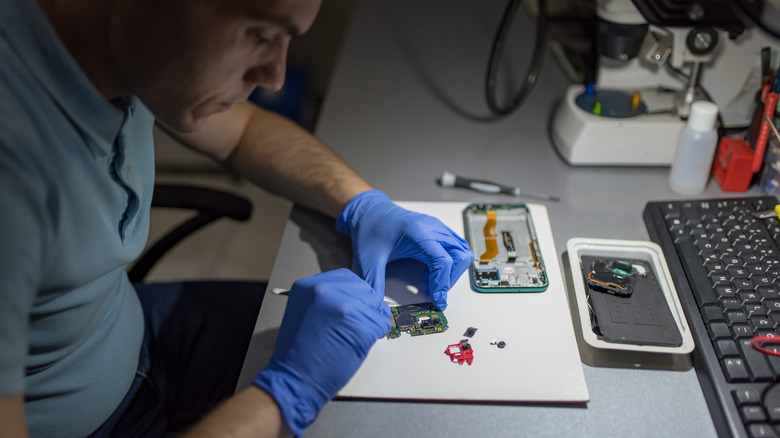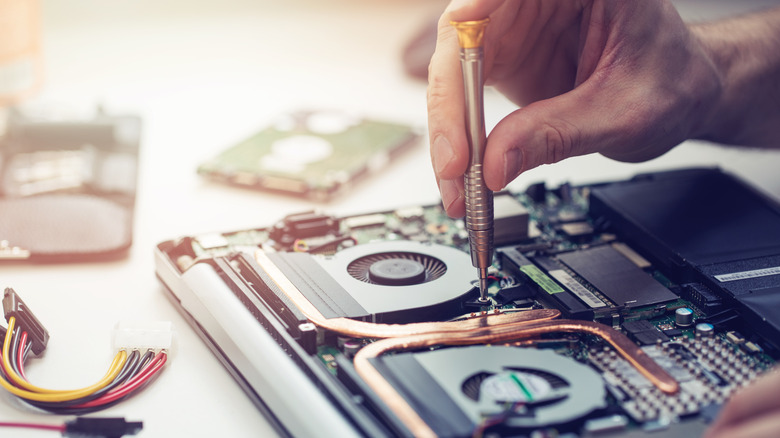What Is Right-To-Repair And Why Is It So Important?
There was a time when smartphones weren't so smart. They were basically just plain old phones. Their capacities, of course, have skyrocketed since, and so have their price tags. The iPhone 15 Pro Max, for instance, starts at $1,199. For an often hefty chunk of change, consumers get a device that, according to Statista, lasts about 2.67 years in 2023. This can mean that the lifetime cost of the device is even higher if costly repairs are necessary as it ages.
Buyers want to know they'll have some degree of protection when buying a new gadget. Warranties tend to focus on defects that aren't the users' fault, meaning that accidental drops and such can leave them with no option but to replace something potentially pricey at their own expense. This is handy for manufacturers who want their customers to leap on board with their latest upgrade, but those same manufacturers should beware: the right to repair is gathering legal momentum, and consumers can derive great benefits from it.
Here's what right-to-repair entails and why it matters so much to manufacturers and customers.
What is right to repair?
The Right to Repair Act was signed in California in October 2023. It builds on the robust protection of the state's Song-Beverly Consumer Warranty Act, which was added to the legislature over five decades prior. Song-Beverly's purpose is to ensure that applicable California-purchased products are maintained under the terms of their warranties and that if any appropriate repairs are needed, the avenues are available to have them made. Should the same issue(s) persist after what Song-Beverly deems a "reasonable" amount of such repair efforts, the manufacturer is obligated to refund the buyer or provide a replacement.
California's implementation of Right to Repair goes further still, meaning that manufacturers must supply the necessary parts, equipment, and manuals for repairing applicable products for a period of either three or seven years, depending on the value of the production question (between $50 and $99 in the former case and more than $100 in the latter).
Consumers should, in short, have the right to a product that works as specified for its lifetime. Issues and defects will, sadly and inevitably, arise at times. When they do, it shouldn't be a terrible hassle to have them rectified or even have repairs performed by the customer themselves. In some cases, as noted by the UK's own right-to-repair legislation, the law is intended to allow DIY repairs of less complex issues while ensuring that parts are available for tradespeople to tackle harder ones.
The great importance of right to repair
On a surface level, right-to-repair makes perfect sense. Few would argue with the core concept: If you buy an expensive device or any consumer product and use it as intended, it should work as intended. In California, pricier items have longer-lasting protection. There's much more to it than that, though. Right-to-repair isn't just about convenience or saving money. It will help contribute to efforts to clean up our planet.
So many of us are guilty of discarding our devices when they break or are replaced through upgrades. Statista reports that the scale of the problem is immense: the world's electronic waste every year exceeds 50 million metric tonnes. Each right-to-repair law makes it easier to access repairs and more practical and viable. Perhaps, then, it could go some way to changing the world's habits and lessening the harmful impact of production.
As Californians Against Waste's Nick Lapis put it when the law was acknowledged (iFixIt reports), "This is a common-sense bill that will help small repair shops, give choice to consumers, and protect the environment." There's so much at stake for our planet, and many ask what they, as individuals, can do. Embracing right-to-repair and advocating for it may be one such thing.


